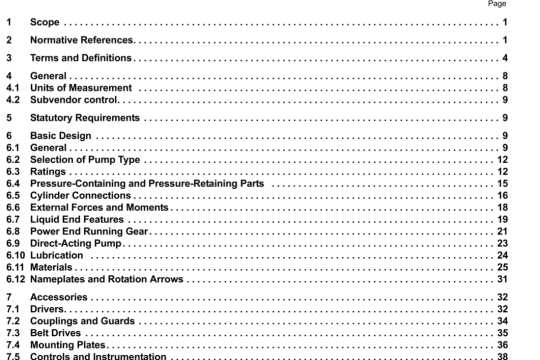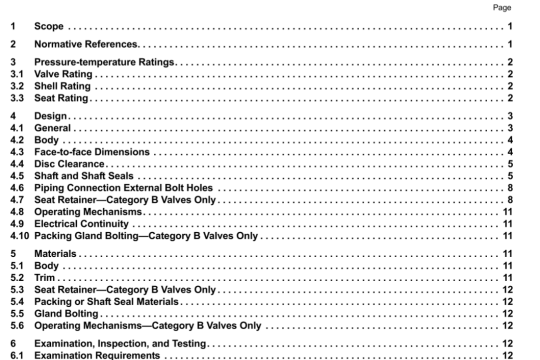API RP 2001:2012 pdf download
API RP 2001:2012 pdf download.Fire Protection in Refineries.
5.8 Pressure Relief and Flare Systems
5.8.1 Gneral
For the design of prassure-reheving systems, refer to API 520. API 521, and API 2000. The design of flare facilities is discussed in API 520, API 521, API 537, and in 5.8.3. For requirements on safety valve installation, set pressures, and valve arrangement, refer to ASME Boiler and Pressure Vessel Code, Section VIII: Unfired Pressure Vessels. Subsequent discussions of design wl be bmiled to problems associated with fire and explosion risks involving pressure-relief or flare facihties.
5.8.2 Relief Valves
Safety-i-ehef valves are provided to prevent overpressure of refinery equipment ii emergencies created by operational errors, equipment failures, and fire and to ensure the safe disposal of released matenals. When block valves are Installed on either side of relief valves, those block valves must be locked or secured In the open position wtiile the relief valve is an service. Relief valves that release liquid hydrocarbons should discharge Into a dosed disposal system. Where only hydrocarbon vapor is vented, relief valves may discharge directly to the atmosphere If certain conditions are met. These Indude the following:
a) proper distances between point of release and personnel areas:
b) conformance with relevant environmental regulations for emergency releases;
C) low toxicity;
d) temperature below autoignition;
e) dispersion of released material based on discharge velocity, molecular weight, condensing temperature, and other physical properties of the material.
Safety relief valves should be tested at scheduled intervals to determine whether or not they will function at the designated pressure. The test interval will vary from several months to several years, depending upon the cleanliness of the service, the severity of operating conditions, the results of previous inspections, and the existence of legal requirements. The frequency of the test should be established for each valve on the basis of operating experience. engineenng judgment, and industry practice (see API 576). When block valves are instaled below relief valves, many facilities require that they be car-sealed or locked open while the unit is in operation. If the valve is dosed so a PRV can be removed for testing or service, equivalent overpressure protection is required while the unit is in operation. Often a replacement valve is installed and the valve reopened.
Where relief valve discharges are routed to a closed system, headers should be sized to handle the maximum flow resulting from any single contingency without developing excessive back pressures on the relief valves connected to the system. Where safety relief valves are connected into closed emergency relief systems, the grouping of equipment within one fire risk area may influence the size of the relief facility piping required. By providing reasonable separations between groups of equipment, the quantity of materials released into the flare systems under fire conditions can be reduced. Fire-related electric power failure should be included ii flare system contingency analysis.
Conditions under which the system can become plugged, blocked, or frozen should be avoided, and piping should be designed without “pockets” and sloped toward liquid knockout drums to avoid the accumulation of liquld that may cause surging, plugging, or freezing.
If a closed emergency relief system serves more than one unit, it may be necessary to isolate sections of the system when individual units are shut down. Therefore, the location of adequate facilities for blinding or isolating the unit should be examined, When isolating a unit, the integrity of overpressure protection for other units should be in accordance with relevant API or ASME standards.
When safety•relief valves discharge to the atmosphere, vent stacks should terminate above adjacent equipment Otherwise, localized overheating of nearby process vessels might result from radiation or convective heating if the valve should open and vapors ignite during a fire or other abnormal condition.
Drainage on the discharge risers of atmospheric safety valves should be designed to reduce the likelihood of problems. If drains become dogged. condensed hydrocarbons from leaking safety valves can accumulate and subsequently be blown over the unit if the valves release. If the material reaches an ignition source, a fire could result. If water accumulates in the vent stack, freezing may occur, either as a result of low ambient temperatures or from the refrigeration process caused by rapid evaporation of leaking low boiling point hydrocarbons
Drains should be installed at the bottom of the riser Care shotid be taken with regard to drain orientation so that under fire conditions, any buming vapor discharged from the valve opening will not impinge on equipment. Installation of elbows In the drain to direct any released vapor away from nearby vessels or piping can reduce this possibility.




